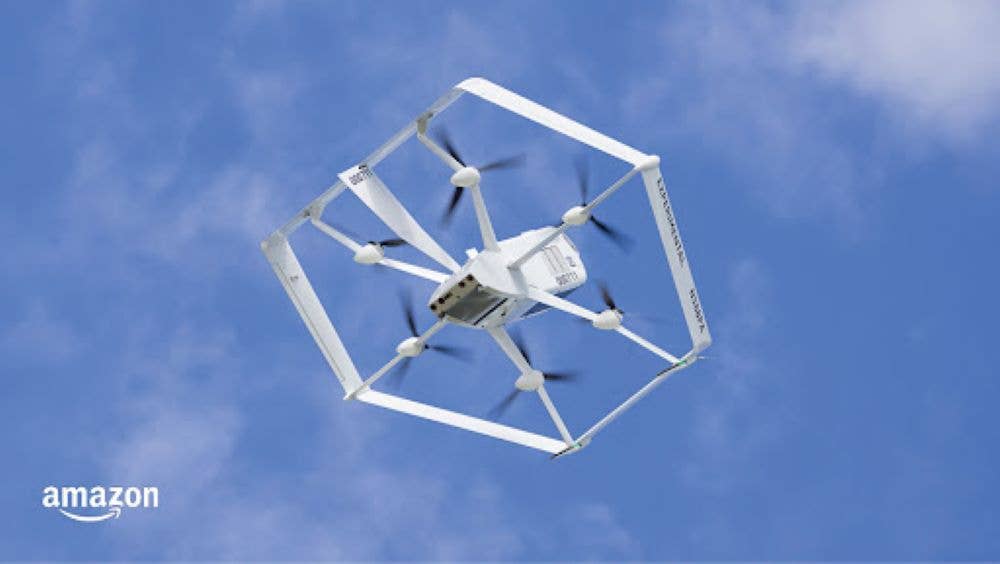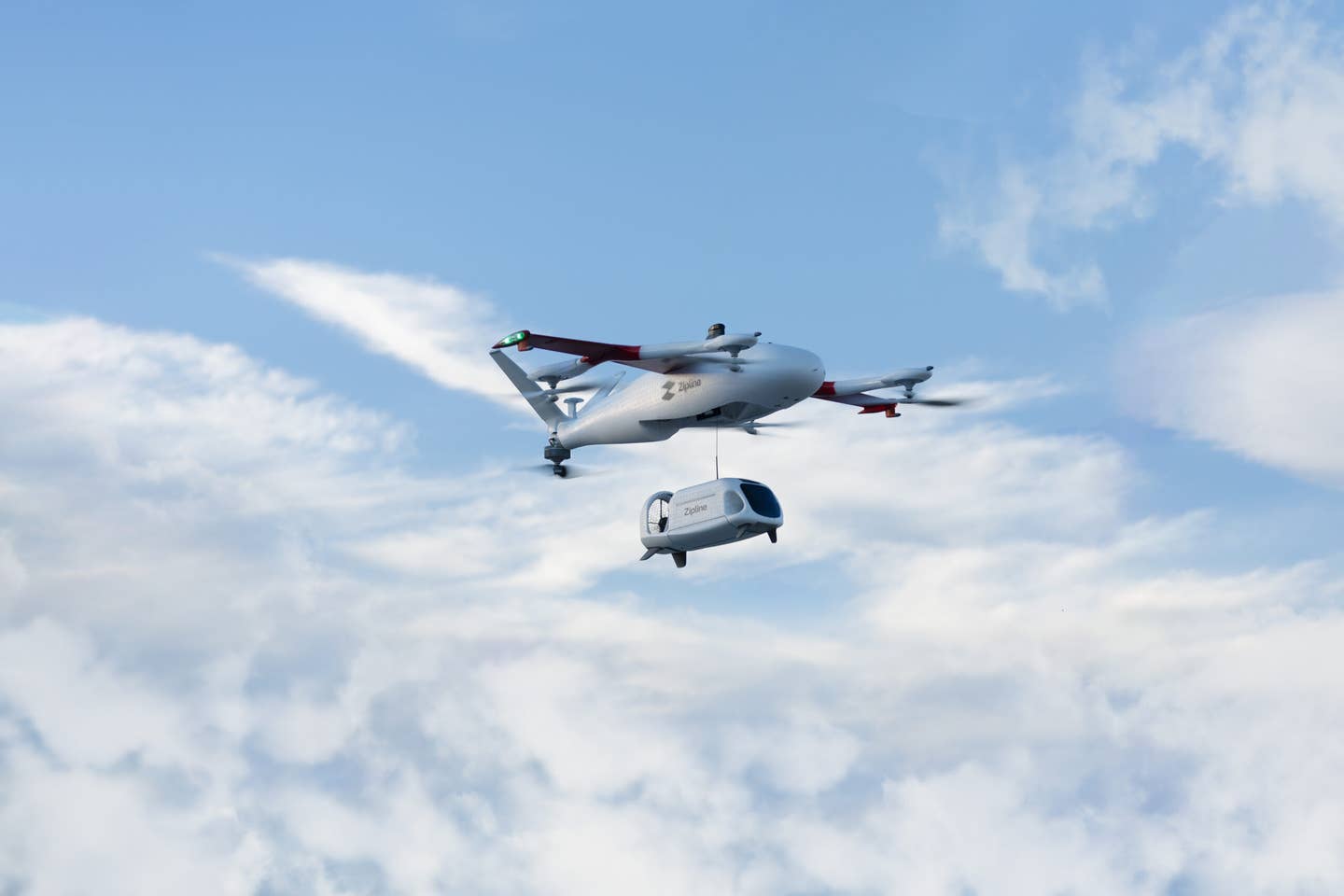Amazon, Beta Air, U.S. Navy Published Patents Last Month
We break down the biggest drone, unmanned aircraft systems, and advanced air mobility-related patents from April 2023.

Amazon Prime Air’s MK27-2 drone, pictured, could get an upgrade. [Credit: Amazon]
Much of the action in the advanced aviation space happens behind closed doors. Unless you’re friends with an Amazon Prime Air engineer or a U.S. military flight tester, the inner workings of modern flying innovation are opaque at best.
But every now and then, innovators give us a peek behind the curtain—if you know where to look.
Welcome to Patent Pending, FLYING’s monthly roundup of the biggest drone, unmanned aircraft systems (UASs), and advanced air mobility (AAM)-related patents. Each month, we’ll save you hours of parsing through U.S. Patent and Trademark Office filings by breaking down the most interesting, outlandish, and eye-popping technologies that have yet to hit the market.
A few notes: Just because a patent was published does not mean it has been granted, and there is no guarantee that a company will develop patented technology. That being said, published patents can provide some insight into a firm’s research and innovation priorities—and a lot of them are just cool.
Here are a few published in April:
Amazon
Amazon’s Prime Air drone delivery program may be struggling, but a pair of 2020 patent filings could shake things up.
The first is all about agility. Published on April 25, the filing describes a set of replaceable components for unmanned aerial vehicles (UAVs) that can be quickly serviced or swapped out. It also details a system for determining the ideal service frequency of each component, allowing for the most frequently serviced parts to be placed in the most accessible locations.
The second, published the same day, describes a new component that could be added to Amazon’s drones. It calls for modular storage units containing bays or compartments that could be used to transport multiple different orders. The filing also describes temperature- and humidity-controlled variations, which could enable deliveries of different categories of goods (i.e. ice cream and chicken wings).
Crucially, these modular units would be reconfigurable. Amazon describes a scenario where one unit can be installed and removed from multiple UAVs, depending on the storage needs of each delivery. That could allow the company to consolidate several trips into one.
BETA Technologies
Shifting gears from delivery drones to passenger electric vertical takeoff and landing (eVTOL) aircraft, air taxi developer BETA Technologies also had two patents published last month—and both were filed around this time last year.
One, filed last April, describes a hybrid propulsion system for fixed-wing eVTOL. The system would rely on a “power unit pod” containing an electricity-producing auxiliary power unit and a fuel tank containing traditional jet fuel, kerosene, gasoline, or hydrogen gas. The goal, it seems, would be to extend the range of the aircraft.
A second BETA patent filed a month later, focuses on what happens on the ground. It lays out a service system that would charge the firm’s aircraft, including a cooling mechanism to regulate the temperature of the battery. It would also measure how much charge the aircraft has left.
Honeywell
While BETA examines an emerging fuel source for passenger aircraft, Honeywell has its eye on the future of fuel for small UAVs.
Electric batteries are currently the standard for small drones. But a 2019 Honeywell patent filing describes a hydrogen fuel cell-based generator that could charge both battery-electric and fuel cell-powered drones. Power from the generator would be transferred to a controller, where a drone could land and charge.
The solution is designed to be lighter and more compact than a typical fuel cell-based generator, requiring no net water consumption, which eliminates the need for a water fuel reservoir. But according to the filing, it would also enable up to 12 times the run and flight time of a typical lithium-ion battery.
The U.S. Navy
The U.S. military is no stranger to UAVs and UASs, having awarded a multitude of contracts to drone firms and others. But the Navy last month had one of its own innovations published.
Essentially, it’s a catch-and-release system for friendly UAVs. Filed in 2021, the patent describes a system that uses small robotic arms to secure a drone to a landing platform, where it can then charge and be released back into the air.
In order to properly align itself, the platform would be able to swivel or move side-to-side along a groove. According to the filing, the system is “primarily designed for use on a moving landing platform”—like a ship.
And a Few More Patents
Now, let’s get into some fun ones.
Hong Kong-based Hex Technology is looking at building drones that can “mate” (not in the typical sense, of course). A 2020 filing describes a UAV design that includes an opening and a recess at either end of the fuselage, allowing the drones to land on top of each other and be stored in a stack. Moreover, they’d be capable of taking off while stacked, reducing the space required to house a swarm of drones.
At the other end of the fun spectrum, the most dystopian-sounding drone patent published last month came from Liberty Mutual—and yes, I’m talking about the insurance company. In a 2019 filing, LiMu describes a drone equipped with an array of sensors to be used in an array of insurance applications, like home inspections.
The company imagines aircraft with digital and thermal cameras or sensors that monitor heat, light, sound, air quality and a host of other conditions, which could be used to inspect roofs, construction sites, amusement parks or any number of settings. But if you ask me, I wouldn’t want Liberty Mutual drones buzzing around my house.
Luckily, this next innovation involves UAV tech that would operate far from home. Filed in 2020 by Japan’s NTT, a patent describes a truly amphibious drone capable of moving not just through the air and on the ground, but also over water.
NTT, a communications company, would use this amalgamation of a UAV to inspect manholes without a human. It would be able to fly to an inspection site; land on the ground; position itself over the manhole; enter through the opening; and land on top of any water that has accumulated at the bottom. Then, it could take photos of the manhole’s interior.
Similarly, the Saudi Arabian Oil Company, or Aramco, filed a patent in 2021 for UAV technology that could inspect congested pipelines. The system would be used to locate and track scrapers, which are essentially a cleaning mechanism for pipeline settings.
A handful of the patents outlined above—like BETA’s recent filings—will make it into development. Others, like Liberty Mutual’s home inspection drone, won’t—I hope. But they represent a glimpse into the world of advanced aviation innovation.

Sign-up for newsletters & special offers!
Get the latest FLYING stories & special offers delivered directly to your inbox






